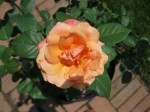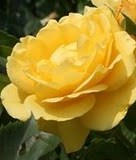
The name “floribunda” says it all; flora means “flower”, and abundo means “having in large supply” so the name “floribunda” aptly describes a rose having an abundance of flowers. Floribundas were created in the early 20th century as the result of breeding a polyantha rose that bore small flowers in clusters with a hybrid tea rose that bore large flowers singly on long stems. The first polyantha/hybrid tea cross, made in 1909, produced ‘Gruss an Aachen’ with large shapely pink flowers 3” across, borne in clusters of up to 7 flowers on a compact 3’ bush. A breeding program followed and in 1930 the name ‘floribunda’ was used to describe this group of roses. Floribunda inherited their large flowers from their hybrid tea parentage and increased hardiness as well as continuous bloom from the polyanthas heritage. Many floribunda roses have been created since 1930 and some have won recognition from the American Rose Society for their fragrance and overall garden performance.
There are many different floribunda roses but here are the general characteristics. Some cutivars are more like hybrid teas than others.
Flower Size: Up to 5” across
Number of Petals: 5-35 (but ‘Johann Strauss has 100 petals!)
Flower Form: Flat to high centered (like hybrid teas); flat cultivars often have ruffled petals.
Flower Substance: Generally good, making them more weather resistant than hybrid teas.
Flower Color: 18 color classes as defined by American Rose society (like hybrid teas) such as white, red, pink, lavender, orange, yellow, blends, and stripes, ; no black or blue.
Stem: Flowers borne in clusters of 3 to 7 or more on medium length stems.
Fragrance: Fragrance varies from heavy to mild, to non-existent.
Size of Bush: Rounded, bushy, 3-5’ high and wide (tend to be smaller than hybrid teas and more compact)
Disease Resistance: Variable but in general more resistant than hybrid teas.
Hardiness: Variable but some are hardy to zone 4 with winter protection (hardier than hybrid teas)
Heat Tolerance: Variable, depending on the cultivar.

Many floribundas are available, some dating back many years but still popular. The most popular floribunda is ‘Iceberg’ that produces large clusters of –4’ wide white flowers on a medium to tall bush that is disease resistant and extremely hardy. This rose has been around since 1958 and is still the most widely seen floribunda. Other oldies but goodies include ‘Sunsprite’ (deep golden yellow), ‘Sexy Rexy’ ( medium to light pink), ‘Dicky’ (reddish salmon pink with lighter reverse), ‘Lavaglut’ (deep red). New introductions of note are ‘Easy Does It’ (mango peach apricot blend), ‘Julia Childs’ (butter yellow), and ‘Cingo de Mayo’ (Smoky lavender and rusty red-orange blend).
If you want to grow some roses, there are probably some floribundas that you will find great assets to your garden as well as for cutting. They are relatively easy to grow and give a lot of color over the growing season. They are varied in form, fragrance, color and most are small enough to fit into to even a small garden so there is one out there for everyone.
